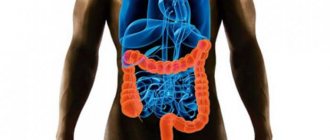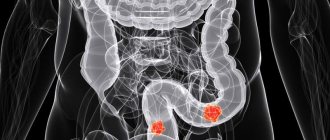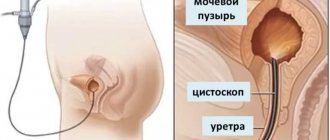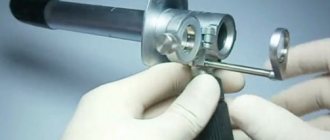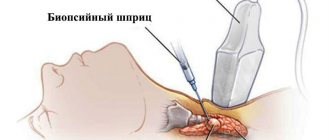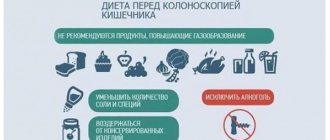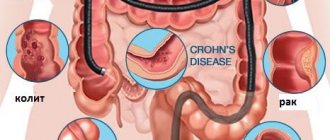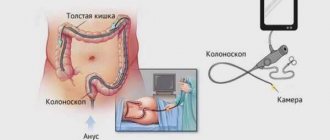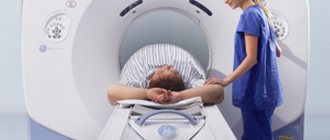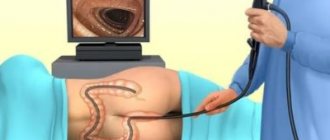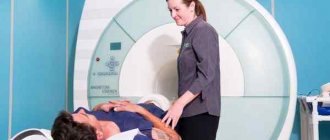What is irrigoscopy and why is it so important to prepare for it correctly?
Irrigoscopy is a method of examining the large intestine, which is prescribed to the patient if the attending physician cannot make a diagnosis by visual examination. Using irrigoscopy, you can diagnose various types of tumors, ulcers, etc.
There are two types of irrigoscopy:
- contrasting;
- double contrast.
The difference is that with the double method, air is injected along with the contrast agent. This allows for more detailed visualization.
The reliability of the results of irrigoscopy directly depends on how well the intestines are prepared for the examination.
Photo gallery
Irrigoscope device
Equipment for the procedure
Irrigoscopy results
The radiology doctor will tell you how to properly prepare for irrigoscopy on the visus-1 channel.
Where is irrigoscopy performed, how much does the study cost?
You can undergo irrigoscopy both in private medical centers and in government institutions. The price will vary depending on the internal pricing policy of each specific organization, but in public hospitals and clinics it will be slightly lower than in private centers.
When visiting regular hospitals, you may have to wait quite a long time, while in private clinics the procedure will be faster.
The price includes:
- payment for the service itself;
- price of contrast agent;
- interpretation of images by a radiologist;
The examination is not cheap and on average ranges from 3,500 to 4,500 rubles. In emergency situations in hospitals, diagnostics are carried out free of charge; you may only need to pay for the contrast agent.
Intestinal irrigoscopy does not harm human health. The main difficulty is the need for preliminary bowel preparation, diet, and cleansing enemas.
You can use the method as often as necessary. During treatment, the picture obtained on the images does not change within a few days, so usually for control, irrigoscopy is performed 2 times a month to assess the adequacy and effectiveness of the treatment received by the patient.
Article design: Mila Friedan
Indications and contraindications for irrigoscopy
The main indications for the examination are the following reasons:
- feeling of pain or discomfort in the anus;
- suspicion of malignant neoplasms of the intestine;
- the presence of blood, mucous or purulent discharge in the stool;
- chronic intestinal disorders: constipation, diarrhea;
- colitis;
- acute intestinal obstruction.
The reasons why irrigoscopy is contraindicated are:
- pregnancy (due to the negative impact of x-ray radiation on the fetus);
- perforation of the intestinal walls;
- colitis in the acute stage;
- severe cardiovascular diseases.
Contraindications
Irrigoscopy has certain contraindications. This procedure is contraindicated in the following cases:
- pregnancy;
- rapidly developing ulcerative colitis;
- in the presence of a disease of the cardiovascular system, as well as other diseases that may not have the best effect on the patient’s condition;
- megacolon, which is toxic.
You should not violate the rules and regulations, otherwise it will affect the patient’s condition.
Nutrition before irrigoscopy
An important part of the algorithm for preparing for the procedure at home is maintaining a proper diet. Experts recommend eating according to the principle of a slag-free diet, the main postulate of which is to consume easily digestible, low-calorie foods. It is necessary to completely exclude “heavy” dishes from the menu.
To understand the intricacies of a slag-free diet, you need to consider the following aspects:
- duration of the diet;
- permitted products;
- prohibited products;
- menu on the last day before the study.
How long to follow the diet
You should start following the diet three to four days before the date of the procedure. This is exactly how long it takes to cleanse the intestines and stomach.
Authorized products
The food consumed before irrigoscopy should be easily digestible, so it is recommended to adhere to the following menu:
- weak broths;
- White bread;
- berry and fruit compotes;
- boiled or steamed meat, fish;
- boiled rice;
- jelly, weak tea;
- semolina porridge;
- cheeses of various varieties;
- low-fat fermented milk products (with the exception of cottage cheese).
Prohibited Products
When following a slag-free diet, you should exclude the following foods from your diet:
- black bread;
- fruits and vegetables containing a lot of fiber;
- any carbonated drinks;
- strong tea, coffee;
- pasta, potatoes, legumes;
- oatmeal, pearl barley;
- hot, salty, spicy;
- fatty fish and meat.
Menu for the last day before the study
The day before the study, you must switch to liquid nutrition.
You can eat:
- vegetable soups;
- light fermented milk products.
And also drink as many liquids as possible:
- water;
- teas;
- dried fruit compotes (without pieces of fruit).
It must be remembered that the day before the irrigoscopy procedure you should not have dinner, but doctors allow replacing dinner with a glass of juice.
Bowel cleansing before irrigoscopy
To cleanse the intestines before the procedure, you can resort to two methods:
- cleansing enemas;
- cleansing with medications.
Cleansing enemas
If the patient wants to choose to cleanse the intestines at home using enemas, he needs to remember that before barium enema the enema is done several times:
- before bed the day before the examination;
- after natural bowel movement;
- two hours before the procedure.
For the first time, about a liter of water is injected into the intestines with an enema. The procedure must be repeated until the emerging liquid becomes completely clean.
Medical cleansing
The process of cleansing the intestines can also be carried out with the help of specialized pharmaceutical preparations.
They have different shapes:
- powders;
- liquids;
- pills;
- capsules.
Most doctors recognize drug cleansing of the stomach and intestines as more effective than the traditional method involving the use of an enema.
Experts recommend using the following drugs to cleanse the intestines before irrigoscopy:
- Fortrans;
- Lavacol;
- Duphalac;
- Fleet Phospho-soda;
- magnesium sulfate.
Before you start taking medications, you should consult a specialist and read the instructions.
Fortrans
Fortrans (from 114 rubles per sachet)
The method of using Fortrans is as follows: it is necessary to dilute one sachet per kilogram of weight in the appropriate amount of still water (one liter per sachet). Next, the liquid must be drunk within 3-4 hours. The effect after taking the first dose of the drug occurs after an hour and lasts about six to ten hours. The effect of the drug is based on softening the intestinal contents.
Most patients who took Fortrans to cleanse the intestines noted an unpleasant taste of the drug. However, doctors often recommend this remedy because of its high effectiveness.
Lavacol
Lavacol (from 183 rubles per pack)
The drug is available only in powder form. It is recommended to dilute one sachet per 200 ml of water, however, to achieve the effect necessary when preparing for irrigoscopy, the patient needs to drink 3 liters of water (15 sachets).
Contrary to erroneous belief, Lavacol does not cause dehydration, since it does not suck water from the body, but swells due to the liquid that was taken along with the drug.
Duphalac
Duphalac (from 300 rubles per bottle)
The drug is available in the form of syrup. The advantage of this product is the absence of contraindications for use by nursing women and children. The action is based on softening stool. Duphalac is taken by the patient once after the last meal of the day before the examination (lunch). The recommended dose is 200 ml of syrup, diluted in a small amount of water.
Fleet Phospho-soda
Flit Phospho soda (from 637 rubles per pack)
A laxative based on salts, due to which water is retained in the body and intestinal motility is enhanced. Release form: oral solution. The first portion should be taken in the morning after breakfast, the day before irrigoscopy. One bottle of the drug is diluted in 120 ml of liquid and washed down with a glass of water.
The patient takes the second dose of the drug after dinner (replaced with a glass of juice); the bottle must be diluted and taken in the same way as the morning portion.
In between doses of the drug, you should drink plenty of water. In general, it is recommended to drink at least two and a half liters.
Magnesium sulfate
Magnesium sulfate (from 21 rubles per sachet)
Doctors recommend the use of magnesium to cleanse the intestines somewhat less frequently. This is due to the fact that it is necessary to start taking the drug three days before the date of the irrigoscopy procedure. It is recommended to dilute 20-30 grams of powder in a glass of water; it should be used twice a day: morning and evening the day before the procedure. The laxative effect appears an hour after application.
Carrying out the procedure
Before the first procedure, it is advisable to imagine how irrigoscopy is performed in order to avoid unnecessary anxiety. The procedure can last up to 45 minutes, depending on the purpose of the examination.
An aqueous suspension of barium sulfate is pre-prepared; the temperature of the suspension is about 35 degrees, so that the patient does not feel discomfort. The suspension is pumped into the intestines using a Bobrov apparatus, consisting of a hermetically sealed jar and two tubes. One of the tubes is equipped with a bulb, the second is intended for insertion into the rectum.
First, a survey of the abdominal organs is taken, after which the patient should turn over on his side, bend his legs and put his hands behind his back. A tube is inserted into the rectum and a contrast solution is gradually injected. To ensure proper distribution of the suspension, the patient periodically changes position under the guidance of a doctor. Filling of the intestine with contrast is monitored using a series of images.
As the intestine fills, several targeted and overview images are taken. When the suspension is completely distributed, another overview photo is taken. Based on a series of images, the doctor can assess the condition of the intestinal lumen.
When the tube is removed, a reflex bowel movement occurs, after which another overview image is taken, which shows the relief of the mucous membrane.
After the so-called tight one, double contrast is performed, for which air is carefully pumped into the intestine. This technique allows you to detect changes in the structure of the intestinal walls.
After irrigoscopy, the feeling of bloating in the abdomen persists for some time, and the stool is lighter than usual. As the remaining contrast agent is removed, the color of the stool evens out. Sometimes defecation delays are possible, which should be reported to the doctor. Based on the analysis of the images, the doctor will make a diagnosis and, based on this, explain what you can eat after irrigoscopy. The basis for possible restrictions is not the procedure, but the identified pathology.
Video
A short but informative video will help you understand the intricacies of the irrigoscopy procedure. Filmed by the channel Live Healthy!
Do you have any questions? Specialists and readers of the HROMOSOMA website will help you ask a question
Was this article helpful?
Thank you for your opinion!
The article was useful. Please share the information with your friends.
Yes (100.00%)
No
X
Please write what is wrong and leave recommendations on the article
Cancel reply
Rate the benefit of the article: Rate the author ( 4 votes, average: 5.00 out of 5)
Discuss the article:
